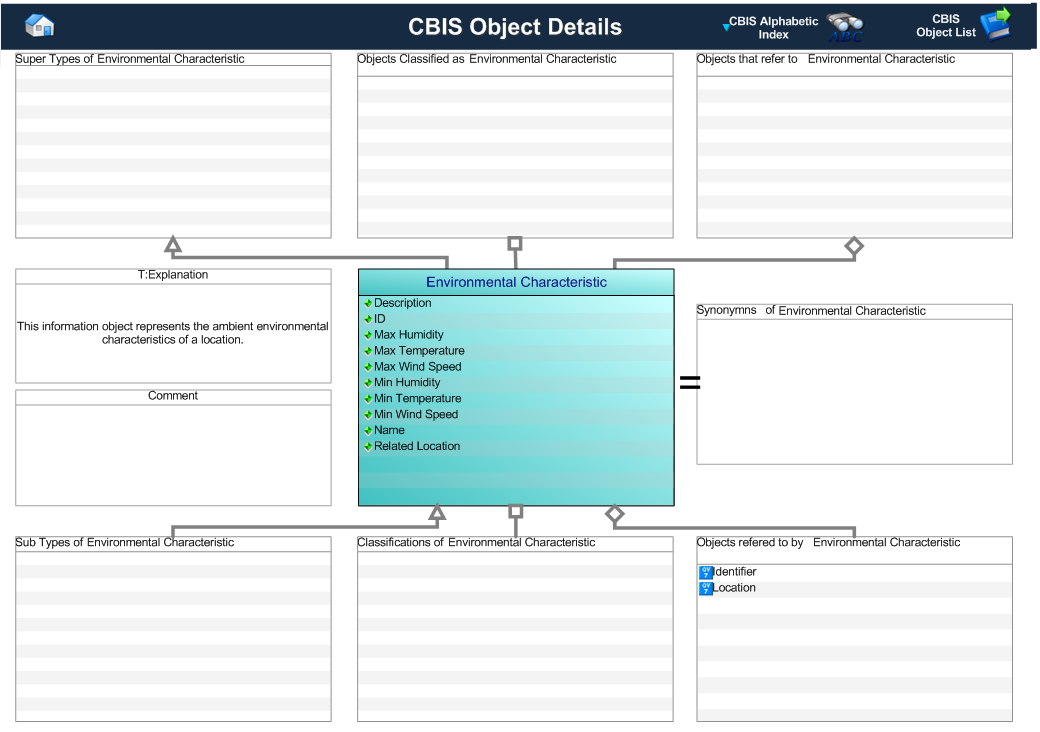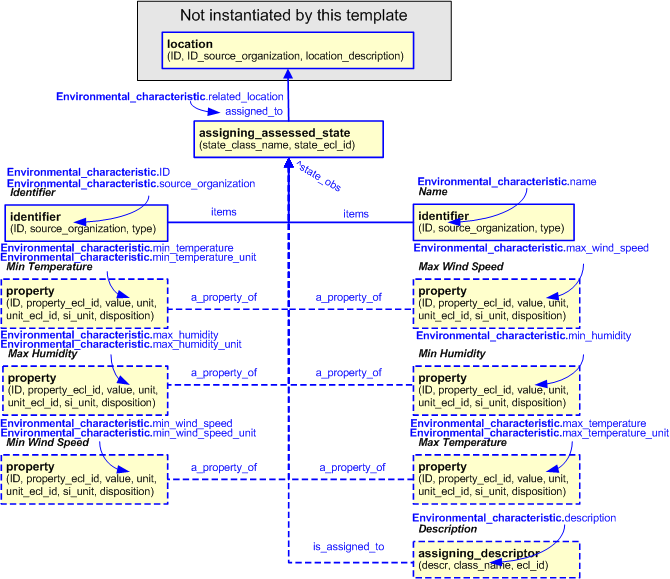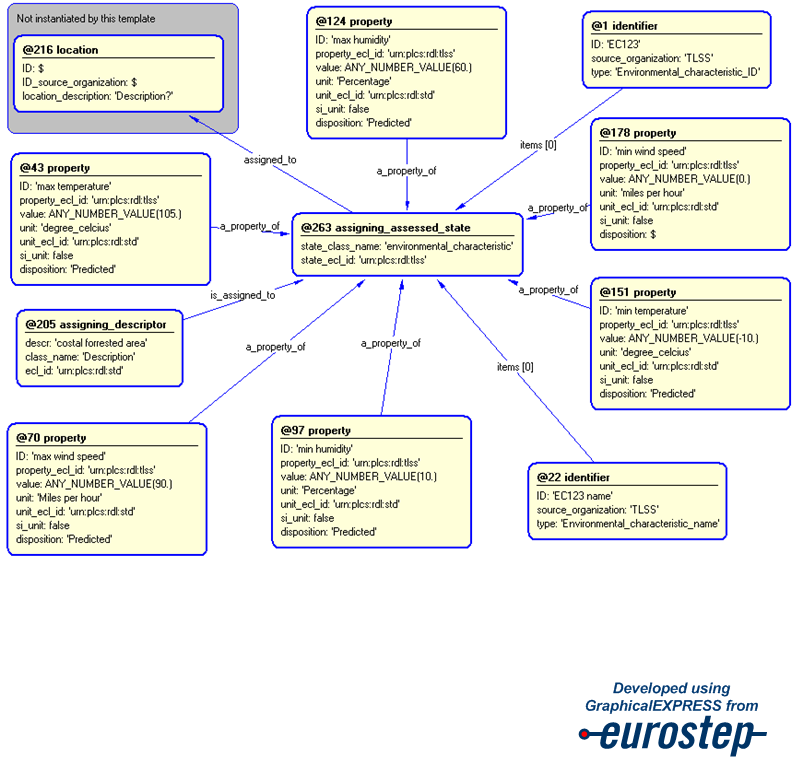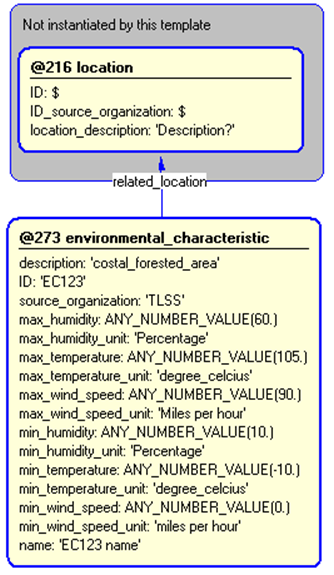Template:— environmental_characteristic (env_char)
Context:— UK_Defence |
Date: 2009/04/17 11:19:12
Revision: 1.3
|
This section specifies the template environmental_characteristic.
NOTE
The template has been defined in the context of
UK_Defence.
Refer to the business context for details of related templates.
NOTE
An explanation of a template and the associated instantiation path is
provided in the
Template overview
section.
This template describes how to represent the ambient environmental characteristics of a location.
The supply node business object is used by those UK_Defence Data Exchange
Specifications that require information about the ambient environmental characteristics of a location.
Figure 1 — Graphical Representation for Business Object Environmental Characteristic
Environmental Characteristic:
The definition of a Environmental Characteristic object is:
Data about the ambient environmental characteristics of a location.
|
Attribute name
|
Attribute description
|
Attribute type
|
Optionality
|
| Description |
This is the description of the environment.
This allows for miscellaneous characteristics (such as sand/dust, terrain, vegetation) to be defined..
|
Intrinsic |
Optional |
| ID |
This is the Identifier of the environment.. |
Identifier |
Mandatory |
| Max Humidity |
This is the maximum humidity at the related location. |
Intrinsic |
Optional |
| Max Temperature |
This is the maximum temperature at the related location. |
Intrinsic |
Optional |
| Max Wind Speed |
This is the maximum wind speed at the related location. |
Intrinsic |
Optional |
| Min Humidity |
This is the minimum humidity at the related location. |
Intrinsic |
Optional |
| Min Temperature |
This is the minimum temperature at the related location. |
Intrinsic |
Optional |
| Min Wind Speed |
This is the minimum wind speed at the related location. |
Intrinsic |
Optional |
| Name |
This is the name of the environment.
This could be used to depict different environmental conditions at different times of year.
EXAMPLE: Spring, Summer, Autumn or Winter Environment.
|
Intrinsic |
Mandatory |
| Located at |
This is the reference to location for which the environment is defined. |
Relationship to Location |
Mandatory |
Table 1 — Environmental Characteristic attribute details
The EXPRESS-G diagram in
Figure
2
shows the templates and EXPRESS entities that are required
to represent the template
"environmental_characteristic".
The text highlighted in blue shows the template parameters.
Figure 2 — An EXPRESS-G representation of the Information model for environmental_characteristic
The graphic for the template to be used in other EXPRESS-G diagrams
is shown in Figure
3
below.
Figure 3 — The graphical representation of the environmental_characteristic template
The following input parameters are defined for this template:
This is the description of the environment.
This allows for miscellaneous characteristics (such as sand/dust, terrain, vegetation) to be defined...
This is the identifier of the environment..
The organization that created the associated identifier. Additionally
a Person or Information System could be defined when either of these are the source; see Identifier template.
This is the maximum humidity at the related location.
The class name of the unit in which the max_humidity value is expressed.
The following classes and their sub-classes can be used:
This is the maximum temperature at the related location.
The class name of the unit in which the max_temperature value is expressed.
The following classes and their sub-classes can be used:
This is the maximum wind_speed at the related location.
The class name of the unit in which the max_wind_speed value is expressed.
The following classes and their sub-classes can be used:
This is the minimum humidity at the related location.
The class name of the unit in which the min_humidity value is expressed.
The following classes and their sub-classes can be used:
This is the minimum temperature at the related location.
The class name of the unit in which the min_temperature value is expressed.
The following classes and their sub-classes can be used:
This is the minimum wind_speed at the related location.
The class name of the unit in which the min_wind_speed value is expressed.
The following classes and their sub-classes can be used:
This is the name of the environment.
This is the reference to the location for which the environment is defined.
The following reference parameters are defined for this template:
Allow the
State_observed
entity instantiated in this path to be referenced when this template is used.
Note: The
State_observed
entity can be referenced in a template path by:
%^target = $environmental_characteristic.env_char%
The following parameter combinations specify a uniqueness constraint:
Unique constraint: environmental_characteristic
Each instance of the
entity
(
State_observed)
within the data set shall be uniquely identified
by a combination of the following parameters on this
template (environmental_characteristic) namely:
ID,
name,
related_location.
The
instance is
referenced by the following template parameter:
env_char.
The instantiation path shown below specifies the entities that are to be
instantiated by the template.
A description of templates and the syntax for the instantiation path is
provided in the
Templates Help/Information section.
/
assigning_assessed_state(
state_class_name="environmental_characteristic",
state_ecl_id='urn:plcs:rdl:uk_defence',
assigned_to=@related_location)/
%^env_char = $assigning_assessed_state.state_obs%
-- instantiate the environmental_characteristic's identification /
identifier(
ID=@ID,
source_organization=@source_organization,
type='Environmental_characteristic_ID',
items=^env_char)/
-- instantiate the environmental_characteristic's name /
identifier(
ID=@name,
source_organization=@source_organization,
type='Environmental_characteristic_name',
items=^env_char)/
-- [optional Max Humidity] /
property(
ID='Max Humidity',
property_ecl_id='urn:plcs:rdl:uk_defence',
value=@max_humidity,
unit=@max_humidity_unit,
unit_ecl_id='urn:plcs:rdl:std',
si_unit='.false.',
disposition='Predicted',
a_property_of=^env_char)/
-- [optional Max Temperature] /
property(
ID='Max Temperature',
property_ecl_id='urn:plcs:rdl:uk_defence',
value=@max_temperature,
unit=@max_temperature_unit,
unit_ecl_id='urn:plcs:rdl:std',
si_unit='.false.',
disposition='Predicted',
a_property_of=^env_char)/
-- [optional Max Wind Speed] /
property(
ID='Max Wind Speed',
property_ecl_id='urn:plcs:rdl:uk_defence',
value=@max_wind_speed,
unit=@max_wind_speed_unit,
unit_ecl_id='urn:plcs:rdl:std',
si_unit='.false.',
disposition='Predicted',
a_property_of=^env_char)/
-- [optional Min Humidity] /
property(
ID='Min Humidity',
property_ecl_id='urn:plcs:rdl:uk_defence',
value=@min_humidity,
unit=@min_humidity_unit,
unit_ecl_id='urn:plcs:rdl:std',
si_unit='.false.',
disposition='Predicted',
a_property_of=^env_char)/
-- [optional Min Temperature] /
property(
ID='Min Temperature',
property_ecl_id='urn:plcs:rdl:uk_defence',
value=@min_temperature,
unit=@min_temperature_unit,
unit_ecl_id='urn:plcs:rdl:std',
si_unit='.false.',
disposition='Predicted',
a_property_of=^env_char)/
-- [optional Min Wind Speed] /
property(
ID='Min Wind Speed',
property_ecl_id='urn:plcs:rdl:uk_defence',
value=@min_wind_speed,
unit=@min_wind_speed_unit,
unit_ecl_id='urn:plcs:rdl:std',
si_unit='.false.',
disposition='Predicted',
a_property_of=^env_char)/
-- [optional description] /
assigning_descriptor(
descr=@description,
class_name='Description',
ecl_id='urn:plcs:rdl:std',
is_assigned_to=^env_char)/
The instance diagram in Figure
4
shows an example of the EXPRESS entities and templates that are instantiated by the template:
/environmental_characteristic(ID='EC1213', source_organization='UK_Defence', name='EC1213_name', description='costal forrested area', max_humidity='ANY_NUMBER_VALUE(60)', max_humidity_unit='Percentage', max_temperature='ANY_NUMBER_VALUE(105)', max_temperature_unit='degree_celcius', max_wind_speed='ANY_NUMBER_VALUE(90)', max_wind_speed_unit='Miles per hour', min_humidity='ANY_NUMBER_VALUE(10)', min_humidity_unit='Percentage', min_temperature='ANY_NUMBER_VALUE(-10)', min_temperature_unit='degree_celcius', min_wind_speed='ANY_NUMBER_VALUE(0)', min_wind_speed_unit='Miles per hour', description='costal forrested area')/
(an illustration of the consolidated environmental_characteristic template is shown in
Figure
5 below.)
Figure 4 — Entities instantiated by environmental_characteristic template
The instance diagram in
Figure
5
shows the graphic symbol for the template that is to be
used in other instance diagrams. The example template is:
/environmental_characteristic(ID='EC1213', source_organization='UK_Defence', name='EC1213_name', description='costal forrested area', max_humidity='ANY_NUMBER_VALUE(60)', max_humidity_unit='Percentage', max_temperature='ANY_NUMBER_VALUE(105)', max_temperature_unit='degree_celcius', max_wind_speed='ANY_NUMBER_VALUE(90)', max_wind_speed_unit='Miles per hour', min_humidity='ANY_NUMBER_VALUE(10)', min_humidity_unit='Percentage', min_temperature='ANY_NUMBER_VALUE(-10)', min_temperature_unit='degree_celcius', min_wind_speed='ANY_NUMBER_VALUE(0)', min_wind_speed_unit='Miles per hour', description='costal forrested area')/
Figure 5 — Instantiation of environmental_characteristic template
Characterizations
No common characterizations of the template
environmental_characteristic
have been identified. However, the ISO 10303-239 EXPRESS model
may enable other assignments to the entities instantiated by the template.




